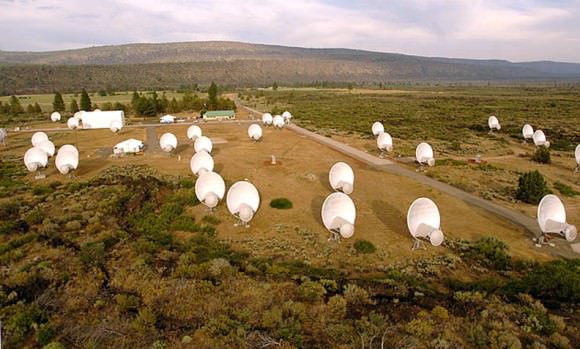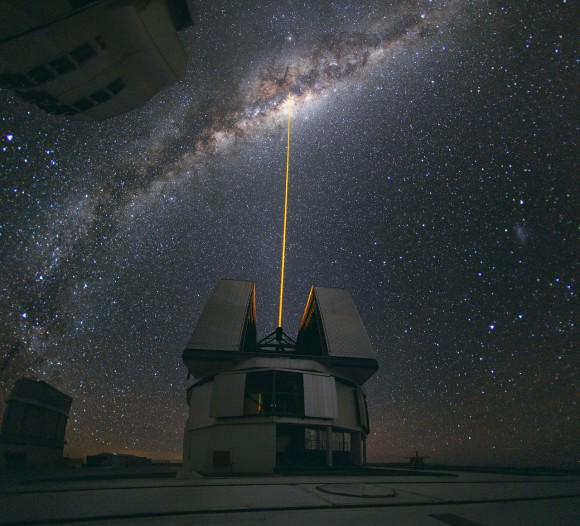I’ve been an avid stargazer for a fair few decades now and not once have I seen anything that makes me believe we are being visited by aliens! My own experiences aside, there’s no evidence of alien visitations but it seems much of the population believes anything that they cannot immediately identify in the sky MUST be ailens. A new paper suggests there are costs associated with increasing claims such as disctractions to government programs and background noise that hampers science communication. How on Earth should we deal with it? If debunking doesn’t work, then maybe its time for a scientific investigation.
Continue reading “Are Claims of Alien Visitation Causing a Problem to Society?”Since Aliens Obey the Laws of Physics, Can We Guess What They Look Like?
Since time immemorial, humans have gazed up at the stars and wondered if we’re alone in the universe. We have asked if there are other intelligent beings out there in the vastness of the cosmos, also known as extraterrestrial intelligence (ET). Yet, despite our best efforts, we have yet to confirm the existence of ET outside of the Earth. While the search continues, it’s fair to speculate if they might look “human” or humanoid in appearance, or if they could look like something else entirely. Here, we present a general examination and discussion with astrobiologists pertaining to what ET might look like and what environmental parameters (e.g., gravity, atmospheric makeup, stellar activity) might cause them to evolve differently than humans.
Continue reading “Since Aliens Obey the Laws of Physics, Can We Guess What They Look Like?”Beyond “Fermi’s Paradox” III: What is the Great Filter?

Welcome back to our Fermi Paradox series, where we take a look at possible resolutions to Enrico Fermi’s famous question, “Where Is Everybody?” Today, we examine the possibility that there is something in the Universe that prevents life from reaching the point where we would be able to hear from it.
In 1950, Italian-American physicist Enrico Fermi sat down to lunch with some of his colleagues at the Los Alamos National Laboratory, where he had worked five years prior as part of the Manhattan Project. According to various accounts, the conversation turned to aliens and the recent spate of UFOs. Into this, Fermi issued a statement that would go down in the annals of history: “Where is everybody?“
This became the basis of the Fermi Paradox, which refers to the high probability estimates for the existence of extraterrestrial intelligence (ETI) and the apparent lack of evidence. Seventy years later, we still haven’t answered that question, which has led to many theories as to why the “Great Silence” endures. A popular one is that there must be “Great Filter” that prevents life from reaching an advanced stage of development.
Continue reading “Beyond “Fermi’s Paradox” III: What is the Great Filter?”Why Haven’t We Found Any Aliens Yet?

Many years ago, Carl Sagan predicted there could be as many as 10,000 advanced extraterrestrial civilizations in our galaxy.
After nearly 60 years of searching without success, a growing list of scientists believe life on Earth only came about because of a lucky series of evolutionary accidents, a long list of improbable events that just happened to come together at the right time and will never be repeated.
Is it possible they are right and we are all there is?
Highly unlikely.
Earth is a typical rocky planet, in an average solar system, nestled in the spiral arm of an ordinary galaxy. All the events and elements that came together to build our world could happen almost everywhere throughout the galaxy and there should be nothing unusual about the evolution of life on this planet or any others.
In a galaxy of hundreds of billions of stars, the law of averages dictates that intelligent life must exist somewhere.
So, why haven’t we found it yet?
There could be many reasons.

Looking for a radio signal in a galaxy of over 400 billion worlds across 100,000 light years and billions of radio frequencies makes the proverbial needle in a haystack sound easy. Imagine you are driving home, your spouse in one car and you in the other. There’s a thick fog making visual confirmation impossible and no cell phone reception. Luckily, a week ago you had a 250 channel CB installed in both cars. Unfortunately, you forgot to agree on a broadcast channel. To chat, the two CBs would have to be on at the same time and you’d need to independently search every channel, listen, broadcast, then move to the next, hoping to get lucky enough to land on the same channel.
What are the odds that would happen? Not very good. Multiply this scenario one hundred billion times and you have some idea of the challenges facing SETI. To add to that, advanced civilizations probably only stay radio active for a relatively short time in their development as they develop more sophisticated technology. Searching the radio spectrum would require looking at one frequency 24/7 for years to be sure you weren’t missing something and telescope time is far too expensive for that. While you were sitting on that single frequency, 20 extraterrestrial signals could have come in on other channels and you’d never know it.
The Fermi Paradox is used by many skeptics as the holy grail when trying to prove there is nobody out there. Fermi theorized that a galaxy with so much potential for life must be full of extraterrestrials. He noted that since the majority of stars are considerably older than our sun, extraterrestrials could be millions of years more advanced than us. Fermi calculated that even at sub light speed one of those civilizations should have colonized the galaxy by now and we would have seen evidence of it.
There is however a problem with that logic.
In 50,000 years, humans will probably look a little different than people do now. In 10 million years, considerably different. Imagine a civilization completely different from us from the start and 10 million years more advanced. We might not even be able to recognize them as life forms, let alone see any evidence of their existence.
Arthur C. Clarke once said advanced extraterrestrials would probably be indistinguishable to us from magic. Their communications would be like listening for an answer to drumbeats and getting only silence while the ether around you is filled with more information in a second than one could utter in a lifetime. There could be the alien equivalent of the super bowl going on a few light years away and we would probably not even have a clue.
The distances in our galaxy are incredibly vast. Current spacecraft travel about 20 times faster than the speed of a bullet. While that sounds fast, at that speed it would take a spacecraft 75,000 years to travel to our nearest star only 4 light years away. Light years are a measure of distance so if we could speed that ship up to 186,000 miles per second (300,000 km/second), it would take 4 years to reach that same star.

Looking at a star 1,000 light years away is like being in a time machine. You are not seeing it as it is now, but one thousand years ago. Our galaxy is about 100,000 light years across with over 200 billion stars. Current theory suggests there may be as many as one billion earth-like planets in our galaxy. If just one tenth of those had some kind of life, that would leave us with about 100 million worlds harboring one celled creatures or better.
If just the tiniest fraction of them, (one one hundred thousandth) managed to spawn an advanced race of beings, there could be as many as 1,000 extraterrestrial civilizations in our galaxy. Regardless of whether you consider that a lot or a little, that would mean one technically advanced alien society exists for every hundred million stars. Our nearest extraterrestrial neighbor might be very, very far away. In the movies, the speculative fiction of warp speed, hyper drive and worm holes enable spaceships to travel faster than the speed of light and breach those distances fairly easily. But if the physics of this turn out to be impossible, then even the nearest alien civilizations may find interstellar travel very difficult and quite undesirable.
Another reason extraterrestrials may have made themselves scarce could be that the galaxy is jam packed with all sorts of weird beings and wondrous destinations. In this scenario why would advanced forms of life want to come here? There are probably so many more interesting places to visit. It would be like hunting for an exotic bird and not even giving the ant hill below your feet a second look.
Stephen Hawking has said, “I believe extraterrestrial life is quite common in the universe, although intelligent life less so. Some say it has yet to appear on Earth.”
Many think once a civilization achieves radio, it has a short window of but a few hundred years before it starts to integrate artificial intelligence into its own biology. Machines do everything so much easier, with far less risk and are immortal. It is entirely possible any aliens we hear from will have morphed into something more machine like than biological.

There has been a push lately for SETI to expand its operations from just passively listening, to actively broadcasting messages into the cosmos. One of the smartest men on the planet, Stephen Hawking, doesn’t think that’s a good idea. He believes that our messages might attract unwanted attention from unsavory creatures looking to blast us back into the stone age. He uses what happened to the Native Americans when they first encountered Columbus as an example. Alien races may have had to endure the same aggressive survival of the fittest culture. If they are at least as smart as Stephen Hawking, then everyone out there could be listening and nobody is broadcasting for fear of attracting the equivalent of Darth Vader and the Evil Empire to their shores.
Or, maybe there is a signal on its way right now, having traveled thousand of years, arriving next week, month or year.
Many scientists like Paul Davies, think SETI needs to start thinking more out of the box in its search methods. He advocates analyzing places in our own solar system like the moon, planets, asteroids and the Earth for evidence that aliens have passed this way. We should also be open to the possibility that we have already received a message from the stars and don’t recognize it because it arrived by something other than radio. Physist Vladimir Charbak thinks that life may have been spread throughout the galaxy by intelligent design and there may actually be evidence of this within our own DNA just waiting to be discovered.
Another reason we have yet to detect alien life could be there is nothing out there to find. Or to put it another way, we are the only game in town. To best answer that question, ask yourself, does this seem logical? There is a very good chance that one or more worlds just in our own solar system harbor some form of life. In a galaxy with as many as one billion or more potentially habitable planets, one could almost guarantee many of them will host life. There may potentially be hundreds of millions of worlds with living things on them. Does it make sense that in all that habitable real estate we are the only race to evolve into an intelligent species?

We humans tend to think of things with a distinctly anthropomorphic spin. Notions like, life needs water, oxygen and is based on carbon. Or, an advanced alien race would use radio and their signals should repeat. In popular culture, extraterrestrials portrayed in movies look remotely like us. This is done so we can recognize emotions and that fills movie theaters. I can remember aliens portrayed in the classic science fiction television show, “The Outer Limits” as energy balls, dust motes and tumbleweeds. They weren’t the most popular episodes, but the reality is that those portrayals are probably closer to the truth than ET and his heart lamp. Extraterrestrials will probably be as different from us as we are from a blade of grass and their motivations a complete mystery. It is very possible that the reason we haven’t found them yet is one that completely eludes our understanding at this point.
So where does that leave us?
Time and patience.
If you compare the 4.5 billion year old earth to a 24 hour clock, mankind doesn’t appear until a little over a minute before midnight. Take the almost sixty years we have been looking for extraterrestrials and project that on the same clock, it probably represents only about 20 or 30 seconds worth of searching for intelligent beings who may have been around millions and perhaps billions of years longer than we have. Our passage through time is just a tiny almost imperceptible blip when compared to the evolution of our galaxy.

New, very powerful listening devices will be coming into operation soon as well as sophisticated instruments that will be able to analyze exoplanets atmospheres to look for hints of life. SETI will expand into new areas and scientists will be able to devote a lot more telescope time to the search as the newly funded (100MM) Project Breakthough Listen kicks into high gear. It will cover 10 times more of the sky and the entire 1-10GHz radio spectrum. There will be more powerful optical and infrared searches and it is estimated the project will generate in a day as much data as SETI produced in an entire year. Recently, Project Breakthrough Starshot was announced as well. Seeded by another 100MM by Russian Billionaire, Yuri Milner, this ambitious project seeks to send a tiny light propelled robotic spacecraft to our nearest star system, Alpha Centauri. Stephen Hawking thinks this can be accomplished within the next generation and that new technology would allow a journey of only 20 years.
SETI scientist Nathalie Cabrol thinks its also time for a new approach to SETI’s search, a reboot if you will. She feels that “SETI’s vision has been constrained by whether ET has technology that resembles or thinks like us. She feels that the search, so far, has in essence been a search for ourselves. Electromagnetic fingerprints of radio transmitions carry a strong like us assumption”. She proposes involving a lot more disciplines in a redesign of the search. Astrobiology, life sciences, geoscience, cognitive science and mathematics among others. Her plan is to invite the research community to help craft a new scientific roadmap for SETI that very well may redefine the meaning of life and the cosmic search for new forms of it.
Some experts say we won’t see evidence of extraterrestrials for another 1500 years. That’s the time it will take for our TV and radio signals to have reached enough stars and have the best chance to be discovered.
In my opinion, I think highly advanced extraterrestrial societies already know we’re here and in about 10-15 years we’ll start getting some of the answers we’ve been looking for.
Are we Ready for Contact?
A common criticism of science is its quick decision to experiment, without thinking about whether or not it should. While many argue that philosophical implications do not belong within the realm of science, others argue that scientists should absolutely consider the broader implications of their results.
Now, neuro-psychologist Gabriel G. de la Torre from the University of Cádiz is questioning whether or not astronomers, who have previously only looked for signs of extraterrestrial life, should actively send messages from Earth.
The idea that we might not be alone in the universe has been around since at least the fifth century B.C., when the Greek philosopher Democritus posited innumerable worlds, none of which were devoid of life.
With the founding of NASA and other space agencies in the 20th century, human beings began to explore the solar system and actively search for alien life. The most ambitious search began in 1960, when astronomer Frank Drake pointed a radio telescope at two stars similar to our Sun and listened for a signature of intelligence.
Drake’s work inspired the Search for ExtraTerrestrial Intelligence (SETI) project, an initiative that began in the 70s with funding from NASA, but has now evolved toward the collaboration of millions of Internet users for the processing of data from the Arecibo Observatory.
But then there is “Active SETI — also known as METI (Messaging to Extra-Terrestrial Intelligence) — which is the attempt to send messages to potential ETs via radio signals. Some astrophysicists, such as Stephen Hawking, have already warned against the risk this implies for humanity. It would favor the arrival of beings with more advanced technology and unknown intentions.
So “can such a decision be taken on behalf of the whole planet?” asked De la Torre. “What would happen if it was successful and ‘someone’ received our signal? Are we prepared for this type of contact?”
To answer these questions, De la Torre surveyed 116 American, Italian and Spanish university students. The questionnaire assessed their knowledge of astronomy, their religious beliefs, and their beliefs on the likelihood of contact with extraterrestrial intelligent life.
The results indicate that as a species, humanity is still not ready to actively contact a supposed extraterrestrial civilization. The students lacked awareness on many astronomical aspects, despite the enormous progress of science and technology. It also revealed that they lack preparation and would instead rely on political and religious figures.
De la Torre encourages SETI researchers to look for alternative strategies until society can better prepare itself. “This pilot study demonstrates that the knowledge of the general public of a certain education level about the cosmos and our place within it is still poor,” said De la Torre. “Therefore, a cosmic awareness must be further promoted – where our mind is increasingly conscious of the global reality that surrounds us – using the best tool available to us: education.”
The paper has been published in the journal Acta Astronautica.



